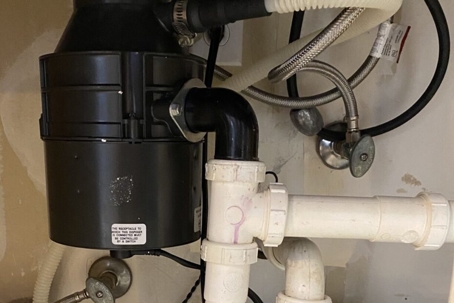Straightforward Techniques for Repairing a Leaky Garbage Disposal
Straightforward Techniques for Repairing a Leaky Garbage Disposal
Blog Article
This article in the next paragraphs relating to How to fix a pretty consistent leak from my garbage disposal is seriously informative. Give it a go and make your own personal final thoughts.

Garbage disposals are crucial cooking area appliances that help in getting rid of food waste efficiently. Nevertheless, a leaking waste disposal unit can be a discouraging and untidy problem to manage. Luckily, several leaks can be repaired conveniently with a couple of simple actions. In this short article, we will go over how to fix a leaking waste disposal unit effectively.
Intro
Garbage disposals are installed under kitchen area sinks and are created to shred food waste into smaller sized pieces, permitting it to pass through the pipes system easily. While these tools are typically reputable, leakages can take place over time as a result of wear and tear, loose connections, or damage to the device.
Step-by-Step Guide to Taking Care Of a Leaking Waste Disposal Unit
Shut off the Power
Before attempting any type of repairs, make sure that the power to the garbage disposal device is switched off to avoid the danger of electrical shock.
Locate the Leak
Determine the specific area of the leak and establish the cause
Tighten Connections
Make use of a wrench to tighten any loosened connections in between the disposal system and the pipes system.
Replace Seals or Gaskets
If the leak results from used seals or gaskets, eliminate the old parts and change them with new ones.
Patching Cracks or Holes
For splits or openings in the disposal device, use epoxy or an ideal patching material to seal the damaged area.
Recognizing the Resource of the Leakage
Prior to attempting to take care of a leaking waste disposal unit, it is vital to identify the resource of the leak. This can generally be done through aesthetic assessment or by carrying out simple examinations.
Visual Assessment
Examine the garbage disposal unit thoroughly for any type of indicators of water leakage. Pay very close attention to locations around seals, gaskets, and link points.
Examining for Leakages
One method to evaluate for leakages is by running water through the disposal unit and looking for any kind of visible signs of leakage.
Typical Reasons For Leakages in Garbage Disposals
Worn Seals and Gaskets
Seals and gaskets play a vital role in protecting against water from leaking out of the garbage disposal. Over time, these components can degrade, causing leaks around the disposal system.
Loose Links
The links between the waste disposal unit and the pipes system can end up being loose over time, creating water to leakage out throughout operation.
Splits or Openings in the Disposal System
Physical damage to the garbage disposal, such as cracks or openings in the housing, can additionally lead to leakages.
Tools and Products Needed for Repairing a Leaking Waste Disposal Unit
Prior to beginning the fixing process, gather the necessary devices and products, including a screwdriver, flexible wrench, plumbing professional's putty, substitute seals or gaskets, and epoxy or patching material for fixing splits or openings.
Evaluating the Waste Disposal Unit After Repair Service
Once the fixing is total, evaluate the garbage disposal by running water with it to make certain that the leak has been fixed.
Preventive Maintenance Tips to Stay Clear Of Future Leakages
To avoid future leakages, it is important to do regular upkeep on your garbage disposal. This includes maintaining it tidy, avoiding placing non-food products or difficult objects down the disposal, and occasionally looking for leaks or other concerns.
Verdict
To conclude, dealing with a dripping garbage disposal is a reasonably simple procedure that can be completed with standard tools and products. By adhering to the steps outlined in this article and exercising preventive maintenance, you can keep your waste disposal unit in good working problem and avoid expensive repairs in the future.
What to Do About a Leaking Garbage Disposal
A leaking garbage disposal often goes unnoticed until you confront a sopping cabinet, a foul-smelling puddle, or an audible drip-drip-drip from the unit. The fix can be frustrating, too, because the leak can stem from a number of components in the system. Fortunately, with a little sleuthing, you can zero in on the leak and—depending on the exact location—stop the icky oozing and repair the component that caused it. Worst case scenario, if it turns out that the garbage disposal must be replaced, installing a new one is a reasonable do-it-yourself task for those with basic plumbing skills. Read on to keep the cash you’d otherwise hand over to a pro.
Prepare to find the leak
Prior to testing the garbage disposal for leaks, unplug it at the wall outlet and turn off the power from the breaker box to prevent electrical shock. Then insert a watertight sink stopper into your sink drain and wipe the unit dry with a clean cloth. In any handy container, mix a few drops of food coloring into a few cups of water, and pour the dyed water onto the sink stopper to help you locate the leak.
Investigate the source
the top, where the disposal meets the sink drain the side, where the dishwasher hose or main drain pipe connects to the disposal or the bottom of the unit Inspect each of these locations while gliding a light-colored rag over the unit; the dyed water will readily show on the rag and reveal the location of the leak. If a leak isn’t immediately apparent, remove the sink stopper and pour a few more cups of dyed water down the sink drain, then check for leaks again. Leaks near the top of the unit are more likely to show themselves while the sink is plugged, while side and bottom leaks are more noticeable while the sink is unplugged.
The metal sink flange that sits directly inside the sink drain is typically sealed around the top with plumber’s putty (a clay-like sealant) and then secured from under the sink with bolts. If the plumber’s putty deteriorates, or the bolts loosen, the flange can no longer form a watertight seal between the sink drain and the disposal—which could cause a leak at the top of the unit.
To reseal the leaky flange, you must first detach the garbage disposal. Start by loosening the screws securing the main drain pipe to the disposal, then loosen the screws in the metal clamp securing the dishwasher hose to the disposal and detach the drain pipe and dishwasher hose from the disposal. Loosen the screws in the mounting ring that connects the disposal to the metal mounting assembly beneath the sink, then pull down the disposal and carefully set it on a clean, dry surface. Loosen the bolts in the mounting assembly with a wrench, then pull down the mounting assembly and set it near the disposal.

I am just very occupied with Why Is My Garbage Disposal Leaking From the Bottom? and I hope you appreciated the entire blog post. Enjoyed reading our entry? Please share it. Help someone else check it out. I recognize the value of reading our article about Why Is .
Find Out More Report this page